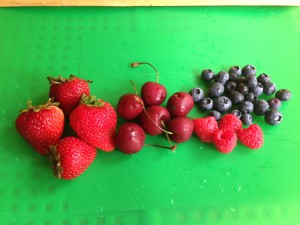[This article is part of a series on brewing with special ingredients. The introduction covered background material and the second installment covered sugars. This installment will span two articles and cover fruits.]
If you have a garden or orchard on your property, or just live near a good farmer’s market, chances are you’ve thought about combining your love of brewing with some of nature’s bounty. In the right kind of beer, fruit can make a nice complement. Sour beers are an especially nice host for fruit flavors; but basically any kind of beer that isn’t too hoppy could be made into a fruit beer. Adding fruit to your beer, in a way that preserves the fresh fruit flavors and aromas, is straightforward. As always, understanding a little about an ingredient will help you
When most people think of fruits, they think of sweet fleshy foods, usually containing seeds, that come from trees, bushes or other plants. These include apples, stone fruits (cherries, peaches), berries (strawberries, raspberries), melons, dates and many others. The botanical definition of fruits is different, and broader, but for the purpose of this article, we’ll use the “kitchen” definition.
Composition
Most fruits are mostly water. Most of the common fruits we would add to beer contain between 80 and 90% water. A few fruits, such as dates, may contain more sugar than water. The second most abundant ingredient in ripe fruit is usually sugars. The most common sugars found in fruit are glucose, fructose and sucrose. Most of the fruits we would consider adding to beer contain between 7 and 15% sugar, which comes from the breakdown of starch in the unripe fruit.
When fruit ripens, its starches (amylose and amylopectin) are converted to sugar. At the same time, the acidity in the fruit begins to decline. When fruit is ripe, it is sweet and aromatic, so that animals will find the fruit, eat it and distribute the seeds (surrounded by “organic fertilizer”) in their environment.
There are many acids in fruit, with malic acid (“apple acid”), citric acid (abundant in citrus fruits) and tartartic acid (“grape acid”) being the three most common types. Other fairly common acids include quinic, oxalic, succinic, benzoic and shikimic.) The pH of most fruit juices in between 3 and 4. Normal beer pH is 4.0–4.4, while sour beer pH is often in the 3.0–3.5 range.
Fruit also contains a small amount of protein (often around 0.5–1.25%) and a small amount of fiber (around 1%). It may also contain pectin, which can cause haze in beer. To prevent this, brewers can add half a teaspoon of pectinase per 5.0 gallons (19 L) of beer when brewing with high-pectin fruits (apples, citrus fruit and berries).
As brewers, what we want from the fruit — the flavor and aroma compounds — comprises only a tiny amount of the fruit, by weight. Most fruits are sweet and acidic, but it’s the aromatic molecules (esters and other volatiles) that largely gives each fruit its characteristic flavor and aroma. Retaining these is a major goal when brewing a fruit beer.
Forms of Fruit
You can brew with fresh fruit or you can use canned, frozen or otherwise preserved fruit. Fresh fruit is great, but requires a little work on the part of the brewer. Basically, you need to remove any extraneous plant parts (esp. stems) from the fruit and pit it if it contains large seeds. You can retain some of the seeds if you want, but they often contribute tannins or other unpleasant-tasting compounds; remember that the seed is the part of the fruit the plant either wants you to spit out or pass through you. (Some pits also contain tiny amounts of cyanide. Not enough to hurt you in homebrew quantities, but it’s a interesting “fun fact.”) The fruit should then be washed before being cut up or blended into small pieces or a mashed into a pulp.
When using fresh fruit, use fruit that is fully ripe (or slightly overripe) and of good quality. You can cut small imperfections from the fruit, but obviously rotting fruit should be avoided. Don’t try to “dispose” of substandard fruit in a fruit beer — you won’t save the fruit, you’ll wreck the beer.
Canned fruit purée is a very convenient form of fruit for brewers. Canned fruit should be sterile (or it would ferment in the can), and it is blended into a smooth mixture. Since fruit is generally canned at a facility near the orchard, purées are made from fully ripe, flavorful fruit. And, since it’s canned, you don’t have to wait for the fruit to come into season. Other types of preserved fruits can also be used, but always check the label for preservatives or other additives you may want to avoid.
In the next installment, I’ll discuss how to add fruit to your beer and what styles make good fruit beers.


I like to use fresh fruit whenever possible. My procedure is to wash, destem/deseed (if needed), and then freeze the fruit. I let the fruit thaw for a day or so before using, then mash it up in the freezer bag by hand before using it. The freeze/thaw cycle breaks down the cell walls within the fruit which releases most of the juice you’re after.
Yep, some people freeze then thaw their fruit. This works well unless the fruit is frozen so long that it gets freezer burn. Good info.